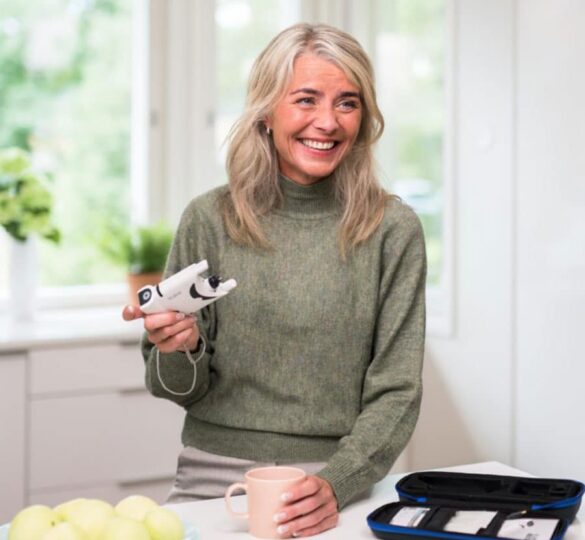Medición de la PIO en el hogar y monitoreo continuo de la PIO
Si usted es un paciente con glaucoma, es importante que usted y su médico controlen su presión intraocular (PIO).

Comprender cómo su presión cambia con el tiempo puede ayudarlo a sentirse más seguro de que el tratamiento está funcionando con efecto.
Por qué es importante monitorear la PIO
La PIO fluctúa constantemente, entre las consultas médicas e incluso durante el día. Cuanto más frecuentemente se mida la PIO, mejor será la evaluación general que tenga su médico de las fluctuaciones de su presión ocular. Esta información puede ser útil para medir la efectividad de su régimen de tratamiento. En la actualidad, el enfoque más común para obtener esta información es medir su presión ocular en la clínica en diferentes momentos del día en varias visitas. Con los avances recientes en este campo, la presión ocular ahora se puede medir fuera de la clínica.
Lentes de contacto “inteligentes”
A medida que la presión ocular fluctúa, la curvatura de la parte frontal del ojo cambia y esto se puede medir con lentes de contacto “inteligentes”. Estos lentes envían una señal a un dispositivo inalámbrico que registra los cambios y muestra indirectamente los cambios en la presión ocular con el paso del tiempo, que pueden corresponderse con el avance del glaucoma. Hace poco la Administración de Alimentos y Medicamentos (Food and Drug Administration, FDA) aprobó los lentes de contacto “inteligentes” con sensor Sensimed Triggerfish® en los Estados Unidos para monitorear la presión ocular.
Tonómetros de uso doméstico
El tonómetro Icare® HOME ha estado disponible para pacientes europeos con glaucoma desde 2014, y ahora está disponible para pacientes en los Estados Unidos. Utiliza una sonda desechable para medir la presión ocular, y puede utilizarse hasta seis veces al día. El tonómetro de uso doméstico toma seis mediciones rápidas de la PIO, luego calcula la presión ocular y la almacena en la memoria del dispositivo. Sin embargo, en este momento, todavía no resulta claro que bien los pacientes pueden utilizar el dispositivo, o cómo los médicos clínicos pueden hacer uso de los datos que brinda. Nuestras actuales técnicas de diagnóstico proporcionan información adecuada para la mayoría de los pacientes. Un estudio más profundo ayudará a determinar la función de esta nueva herramienta de diagnóstico.
El futuro del monitoreo del glaucoma desde el hogar
Los sensores de los lentes de contacto “inteligentes” y los dispositivos de monitoreo de uso doméstico encabezan los avances en la innovación. Los investigadores también han desarrollado implantes oculares diminutos que les permitirán a los pacientes medirse la presión ocular todos los días o cada hora, lo cual podría ayudar a sus médicos a elaborar planes de tratamiento más eficaces y a medida. Un estudio más profundo ayudará a determinar cuándo es apropiado usar estas nuevas tecnologías.
—
Artículo revisado por el Dr. L. Jay Katz.

L. Jay Katz, MD
L. Jay Katz, MD is a member of the Wills Eye Glaucoma Service and a Professor of Ophthalmology at Sidney Kimmel Medical College. He has wide-ranging interests in glaucoma, including drug evaluation, the roles of laser and medical management in glaucoma treatment and optic nerve scanning methodologies and has delivered hundreds of lectures, teaching sessions and courses on these topics.